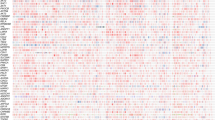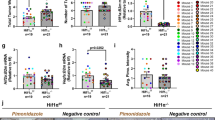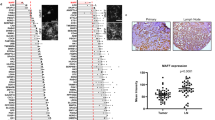Abstract
Metastasis is a multistep process responsible for most cancer deaths, and it can be influenced by both the immediate microenvironment (cell–cell or cell–matrix interactions) and the extended tumour microenvironment (for example vascularization)1. Hypoxia (low oxygen) is clinically associated with metastasis and poor patient outcome, although the underlying processes remain unclear2. Microarray studies have shown the expression of lysyl oxidase (LOX) to be elevated in hypoxic human tumour cells3. Paradoxically, LOX expression is associated with both tumour suppression and tumour progression, and its role in tumorigenesis seems dependent on cellular location, cell type and transformation status4,5,6,7,8,9. Here we show that LOX expression is regulated by hypoxia-inducible factor (HIF) and is associated with hypoxia in human breast and head and neck tumours. Patients with high LOX-expressing tumours have poor distant metastasis-free and overall survivals. Inhibition of LOX eliminates metastasis in mice with orthotopically grown breast cancer tumours. Mechanistically, secreted LOX is responsible for the invasive properties of hypoxic human cancer cells through focal adhesion kinase activity and cell to matrix adhesion. Furthermore, LOX may be required to create a niche permissive for metastatic growth. Our findings indicate that LOX is essential for hypoxia-induced metastasis and is a good therapeutic target for preventing and treating metastases.
This is a preview of subscription content, access via your institution
Access options
Subscribe to this journal
Receive 51 print issues and online access
$199.00 per year
only $3.90 per issue
Buy this article
- Purchase on SpringerLink
- Instant access to full article PDF
Prices may be subject to local taxes which are calculated during checkout




Similar content being viewed by others
References
Cairns, R. A., Khokha, R. & Hill, R. P. Molecular mechanisms of tumor invasion and metastasis: An integrated view. Curr. Mol. Med. 3, 659–671 (2003)
Hockel, M. & Vaupel, P. Tumor hypoxia: Definitions and current clinical, biologic, and molecular aspects. J. Natl Cancer Inst. 93, 266–276 (2001)
Denko, N. C. et al. Investigating hypoxic tumor physiology through gene expression patterns. Oncogene 22, 5907–5914 (2003)
Kagan, H. M. & Li, W. Lysyl oxidase: Properties, specificity, and biological roles inside and outside of the cell. J. Cell. Biochem. 88, 660–672 (2003)
Kaneda, A. et al. Lysyl oxidase is a tumor suppressor gene inactivated by methylation and loss of heterozygosity in human gastric cancers. Cancer Res. 64, 6410–6415 (2004)
Csiszar, K. et al. Somatic mutations of the lysyl oxidase gene on chromosome 5q23.1 in colorectal tumors. Int. J. Cancer 97, 636–642 (2002)
Palamakumbura, A. H. et al. The propeptide domain of lysyl oxidase induces phenotypic reversion of ras-transformed cells. J. Biol. Chem. 279, 40593–40600 (2004)
Kirschmann, D. A. et al. A molecular role for lysyl oxidase in breast cancer invasion. Cancer Res. 62, 4478–4483 (2002)
Payne, S. L. et al. Lysyl oxidase regulates breast cancer cell migration and adhesion through a hydrogen peroxide-mediated mechanism. Cancer Res. 65, 11429–11436 (2005)
Chang, H. Y. et al. Robustness, scalability, and integration of a wound-response gene expression signature in predicting breast cancer survival. Proc. Natl Acad. Sci. USA 102, 3738–3743 (2005)
Chen, Y. et al. Identification of hypoxia-regulated proteins in head and neck cancer by proteomic and tissue array profiling. Cancer Res. 64, 7302–7310 (2004)
Chi, J. T. et al. Gene expression programs in response to hypoxia: Cell type specificity and prognostic significance in human cancers. PLoS Med. 3, e47 (2006)
Palmieri, D. et al. Medroxyprogesterone acetate elevation of Nm23–H1 metastasis suppressor expression in hormone receptor-negative breast cancer. J. Natl Cancer Inst. 97, 632–642 (2005)
Csiszar, K. Lysyl oxidases: a novel multifunctional amine oxidase family. Prog. Nucleic Acid Res. Mol. Biol. 70, 1–32 (2001)
Cen, D., Brayton, D., Shahandeh, B., Meyskens, F. L. Jr & Farmer, P. J. Disulfiram facilitates intracellular Cu uptake and induces apoptosis in human melanoma cells. J. Med. Chem. 47, 6914–6920 (2004)
Janda, E. et al. Ras and TGFβ cooperatively regulate epithelial cell plasticity and metastasis: dissection of Ras signaling pathways. J. Cell Biol. 156, 299–313 (2002)
Friedl, P. & Wolf, K. Tumour-cell invasion and migration: diversity and escape mechanisms. Nature Rev. Cancer 3, 362–374 (2003)
Krishnamachary, B. et al. Regulation of colon carcinoma cell invasion by hypoxia-inducible factor 1. Cancer Res. 63, 1138–1143 (2003)
Fogelgren, B. et al. Cellular fibronectin binds to lysyl oxidase with high affinity and is critical for its proteolytic activation. J. Biol. Chem. 280, 24690–24697 (2005)
Yoon, S. O., Shin, S. & Mercurio, A. M. Hypoxia stimulates carcinoma invasion by stabilizing microtubules and promoting the Rab11 trafficking of the α6β4 integrin. Cancer Res. 65, 2761–2769 (2005)
Leufgen, H. et al. Collagenase expression and activity is modulated by the interaction of collagen types, hypoxia, and nutrition in human lung cells. J. Cell. Physiol. 204, 146–154 (2005)
Kaplan, R. N. et al. VEGFR1-positive haematopoietic bone marrow progenitors initiate the pre-metastatic niche. Nature 438, 820–827 (2005)
Wang, W. et al. Gene expression analysis on small numbers of invasive cells collected by chemotaxis from primary mammary tumors of the mouse. BMC Biotechnol. 3, 13 (2003)
Erler, J. T. et al. Hypoxia-mediated down-regulation of Bid and Bax in tumors occurs via hypoxia-inducible factor 1-dependent and -independent mechanisms and contributes to drug resistance. Mol. Cell. Biol. 24, 2875–2889 (2004)
Moody, S. E. et al. The transcriptional repressor Snail promotes mammary tumor recurrence. Cancer Cell 8, 197–209 (2005)
Tazuke, S. I. et al. Hypoxia stimulates insulin-like growth factor binding protein 1 (IGFBP-1) gene expression in HepG2 cells: a possible model for IGFBP-1 expression in fetal hypoxia. Proc. Natl Acad. Sci. USA 95, 10188–10193 (1998)
Spicher, A. et al. Highly conserved RNA sequences that are sensors of environmental stress. Mol. Cell. Biol. 18, 7371–7382 (1998)
Bedogni, B. et al. Topical treatment with inhibitors of the phosphatidylinositol 3′-kinase/Akt and Raf/mitogen-activated protein kinase kinase/extracellular signal-regulated kinase pathways reduces melanoma development in severe combined immunodeficient mice. Cancer Res. 64, 2552–2560 (2004)
Gilad, G. M. & Gilad, V. H. Beta-aminopropionitrile treatment can accelerate recovery of mice after spinal cord injury. Eur. J. Pharmacol. 430, 69–72 (2001)
Acknowledgements
We thank P. Chu (immunohistochemistry), D. Menke (tail-vein injections), R. Nacamuli (quantitative polymerase chain reaction), R. R. Balise (statistical programming) and C. Davis (board-certified veterinary pathologist); N. Quach (FAK, phospho-FAK and F-actin antibodies), A. Cress (α6 antibody), P. Marinkovich (β1 integrin antibody) and D. Mosher (FN-null cells) for supplying reagents; and P. Friedl, Z. Werb and P. Steeg for discussions. All animal work was performed in accordance with the Stanford University Administrative Panel for Laboratory Animal Care. This research was supported by funds from the NIH (J.T.E. and A.J.G.), the Canadian Institutes of Health Research (K.L.B.), the Else Kröner-Fresenius-Foundation (N.D.) and the California Breast Cancer Research Program (S.S.J.). Author Contributions J.T.E., A.J.G. and S.S.J. conceived and designed the experiments. J.T.E. performed the experiments with the assistance of K.L.B. and N.D. for in vivo work. J.T.E., A.J.G., M.N., J.T.C. and S.S.J. analyzed the data. J.T.E. wrote the paper with the assistance of K.L.B., S.S.J. and A.J.G. The head and neck cancer study was performed by Q.T.L. and C.K.
Author information
Authors and Affiliations
Corresponding author
Ethics declarations
Competing interests
Reprints and permissions information is available at npg.nature.com/reprintsandpermissions. The authors declare no competing financial interests.
Supplementary information
Supplementary Table 1
This table shows associations between LOX and clinical criteria in breast cancer patients10, determined by Chi Square. (PDF 51 kb)
Supplementary Figure 1
This figure demonstrates hypoxic induction of LOX mRNA expression through increased levels and stability. This is shown by semi- and fully-quantitative RT–PCR in human cervical, breast and renal cancer cell lines, and is shown to be dependent on HIF-1 through an identified and tested functional HRE in the LOX promoter. (PDF 283 kb)
Supplementary Figure 2
This figure displays a heatmap of analysed micro-array data showing the genes most strongly correlated to LOX expression in human breast cancer patients from the whole NKI dataset10. Genes of particular interest are highlighted. (PDF 537 kb)
Supplementary Notes 1
This file shows the full list of genes from Supplementary Figure 2. (XLS 84 kb)
Supplementary Figure 3
As Supplementary Figure 2 except dataset is limited to ER-negative breast cancer patients only. (PDF 776 kb)
Supplementary Excel Book 2
This file shows the full list of genes from Supplementary Figure 3. (XLS 84 kb)
Supplementary Figure 4
This figure shows the generation of human cervical and breast cancer cells that stable express LOX shRNA. Assays to show reduced mRNA and protein levels are displayed, as well as in vitro and in vivo growth curves showing no significant differences with control cells. (PDF 122 kb)
Supplementary Figure 5
This figure demonstrates a role for LOX in the increased in vitro invasion of anoxic cervical and breast cancer cells lines. Reduced invasion through LOX inhibition is additionally demonstrated in human head and neck, melanoma, colon, lung, pancreatic and renal cells. Inhibition of in vitro invasion is shown using LOX antibody. (PDF 78 kb)
Supplementary Figure 6
This figure shows a schematic representation of invasive migration, and demonstrates LOX’s independence from FN expression to phosphorylate FAK and increase invasion of hypoxic cells. Data is additionally shown to demonstrate impaired adhesion of SiHa cells to matrix with LOX shRNA expression, and restoration with forced LOX expression. (PDF 692 kb)
Supplementary Figure 7
This figure demonstrates impaired metastatic growth of MDA231 cells expressing LOX shRNA. This is assessed by tail vein injection, growth in soft agar, and growth in Matrigel. Additionally, photographs of the metastatic lesions formed in the lungs from orthotopic studies show reduced size/elimination with genetic/chemical inhibition of LOX. (PDF 455 kb)
Rights and permissions
About this article
Cite this article
Erler, J., Bennewith, K., Nicolau, M. et al. Lysyl oxidase is essential for hypoxia-induced metastasis. Nature 440, 1222–1226 (2006). https://doi.org/10.1038/nature04695
Received:
Accepted:
Issue Date:
DOI: https://doi.org/10.1038/nature04695




